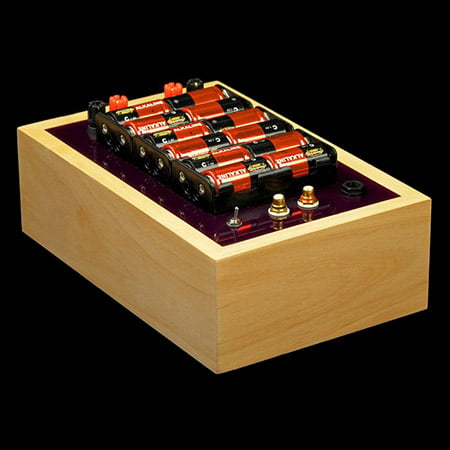Quicksand Specs
The challenge was not coming up with a class D power amplifier in our price point, but rather the need to create a power amplifier requiring no apologies down the road. Sonically, we have always found class D amplifiers to be a little bit on the harsh side, especially at high frequencies and through loud passages. To clean up the dynamic crunch associated with this topology, we took a cue from the Quickie and used a battery power supply. When a class D amplifier is operating at high power levels and at low frequencies, it can actually pump some energy back into the power supply. A typical wall transformer used with such an amplifier will exhibit poor performance under these conditions, and designers must intentionally filter out low frequency content to prevent an unstable power supply from generating distortion in the amplifier. A bank of batteries, however, is easily able to sink that energy without the instabilities of a switching supply. Compared to the evaluation circuit most commonly seen with this device, Quicksand is able to deliver bass two octaves lower without excessive distortion. To open up the high frequency response as much as possible, careful attention was paid to board layout and parts selection, with premium components being supplied and a generous ground plane covering the underside of the PC board. The result is a very clean and dynamic 4 Watt per channel digital amplifier using the TPA3122.
Quiet, efficient battery operation
As a consequence of selecting the battery power supply, Quicksand’s low noise floor means that it is well suited to driving headphones, and will even do quite well with demanding loads like AKG K-1000’s, as well as headphones from Audeze and Hifiman. Being a class D amplifier, nailing down the actual battery life of the Quicksand will depend greatly on the music listened to, load presented to the amplifier, and output level demanded. We have calculated that the amplifier could drain a full set of batteries in 5 hours under the worst of circumstances, and would otherwise operate for just over 300 hours if the power switch was inadvertently left on.
What’s the catch?
Well, we really can’t afford to sell the kit at $99, so will have to be priced at $109. But we will bite the bullet on this limited first run and offer them at an introductory price of $99 until they sell out. We should begin shipping kits in mid to late July.
And, as with the Quickie, batteries are not included. Why should we charge you for batteries that have been sitting on the shelf going stale when you can buy fresh batteries for discount prices online or at your local retailer?

Also the kit comes without a base, just like the Quickie. You can build your own, or we can sell you the same alder wood base kit we supply with our Crack headphone amp kit, for $40, as shown below.
And the last catch is that the chassis plate is made from acrylic plastic and the colors we get are random. Actually that makes it kind of fun – you might get purple like the Quicksand shown above, red, bright yellow, green, white or who knows?
Specifications:
- Gain: 20dB
- Power: 4 Watts per channel into 8 Ohms, 8 Watts per channel into 4 Ohms, 5% THD, both channels driven
- Battery life: 5-300 Hours depending upon how hard the amp is driven. Louder = more power output = shorter battery life.
- Power Supply: 12 C-cell batteries
- Input Impedance: 60K Ohms
